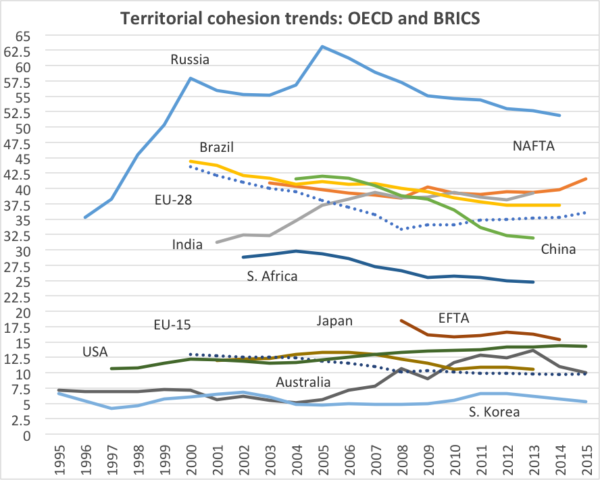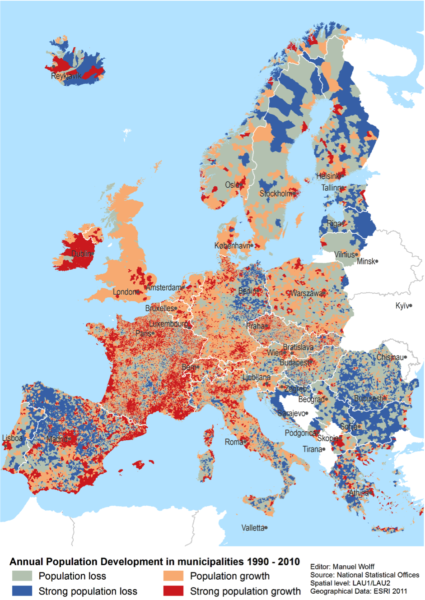Urban and Regional Inequalities in Europe, North America, and BRICS economies, 1980-2015
New research from the Sustainable Urban Development Programme (University of Oxford) and UFZ Helmholtz Centre for Environmental Research in Leipzig (Germany) shows the gap between Europe’s haves and have-nots has been narrowing over the past 35 years.
What is it about?
A major comparative study of European urban and regional growth patterns (forthcoming in next year’s issue of Regional Studies) reveals that since 1980 cities and regions across the EU have been converging economically, becoming increasingly similar in per capita incomes and real growth rates.
The study, which looked at the period 1980-2015, finds that:
- The aggregate decline in regional income inequalities across 28 EU member states (EU-28) from 1980-2015 amounts to at least 7.2%. This refers to the average spread of regional gross domestic product (GDP) per capita across the EU, meaning regional per-capita levels across Europe are over 7% more similar today than they were in 1980.
- Europe’s regional convergence trends have become much stronger since 2000, coinciding with the eastward enlargement of the EU. Between 1995 and 2015, the gap in regional GDP per capita levels decreased by 10.6% on average (see Figure 1 below, based on Eurostat’s data series).

Figure 1: Territorial cohesion trends across Europe (EU-15 and EU-28 member states), 1995-2015
Notes: (a) 0-100 percentage scale, where 0% = perfect equality, with identical GDP per capita values in all regions of the country or economic area; (b) NUTS: Eurostat’s National Units of Territorial Statistics, Levels 1-3.
- The reported decline in regional economic disparities in the EU-28 was the second highest in the world when compared to Europe’s 11 major international counterparts, including the European Free Trade Association (EFTA, consisting of Iceland, Lichtenstein, Norway and Switzerland), the North American Free Trade Agreement area, and emerging market economies such as Brazil, India and China. Between 2000 and 2015, the gap in regional GDP per capita in the EU dropped by as much as 7.4%, second only to a 9.7% drop in regional disparities across mainland China. During the same period, regional economic disparities increased substantially across other areas (including 16.7% in Russia and 3.6% in the United States).

Figure 2: Territorial cohesion trends across major OECD and emerging market economies, 1995-2015
Notes: (a) 0-100 percentage scale, where 0% = perfect equality, with identical GDP per capita values in all regions of the country or economic area; (b) Regional scale: OECD’s Territorial Level 2 regions.
What is driving Europe’s economic equalisation?
Europe’s remarkable progress in economic convergence is due to a combination of free markets and government intervention in the form of active regional policy, targeting state assistance to the lagging regions and cities. Regional convergence has been predicted by a number of theoretical models of economic growth, and the empirical evidence we have gathered is unequivocal. Over the last decade alone, Europe’s newest and poorest member states have been growing 3.3 times faster than the rest of the EU. They have been able to attract foreign direct investment at a rate 7.6 times faster than the EU’s older and wealthier regions. At the same time, Western Europe’s high-wage, capital-rich regions and cities were able to attract the much needed labour resources from the labour-rich, low-wage regions and cities in the East, benefiting the local businesses and consumers.

The second driver of Europe’s long-term convergence has been the EU-wide regional cohesion policy. European regional public investment instruments have grown from €75 billion to €454 billion between 1989 and 2020, with 73% of the total amount going to the poorest regions and cities in the East and South. As workers move westwards, their home cities have to adjust to a smaller labour pool while continuing to attract private capital and public investment from the West (see map).
Why is it important?
Contrary to some caricatures of “Brussels” as a bureaucratic, crypto-socialist juggernaut stifling growth, this research suggests that it is the EU’s single market, with its four freedoms of movement of labour, capital, goods and services, that has propelled faster economic growth and catching-up across the continent. At the same time, this research shows how hopelessly outdated are the views of those, who portray the EU as a capitalist plot created to benefit only giant transnational corporations and further to impoverish the poorest people and places.
Vlad Mykhnenko is Principal Investigator of the project 3S RECIPE (Smart Shrinkage Solutions – Fostering Resilient Cities in Inner Peripheries of Europe. The study ‘State Rescaling and Economic Convergence’ is published online for early access in the journal Regional Studies: https://doi.org/10.1080/00343404.2018.1476754